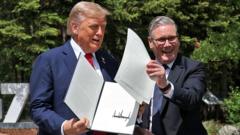As Canada's federal election approaches, the Greater Toronto Area's 56 seats may decide the future of Prime Minister Mark Carney amid escalating economic tensions with the U.S.
Canada's Election: Greater Toronto's Impact

Canada's Election: Greater Toronto's Impact
A looming electoral showdown hinges on the pivotal Greater Toronto area amidst rising Conservative momentum.
In a dramatic shift leading up to Monday's federal election, the spotlight is on Canada’s Greater Toronto Area (GTA), a region that could ultimately determine the outcome of the pivotal political contest. Once a stronghold for the Liberal Party, recent polling indicates that the balance of power is shifting towards the Conservatives, fueled by skyrocketing costs of living and faltering public support for the incumbent Liberal Party under Prime Minister Mark Carney.
The political landscape began to tilt significantly when the Liberals faced an unexpected defeat in a special election in downtown Toronto, marking a loss of a district held by the party for almost three decades. This shockwave rippled through the political community, leading many analysts to believe that it was a catalyst for Prime Minister Justin Trudeau’s downfall and the current general election.
In the context of an economy impacted by President Trump's tariffs on Canadian goods, the importance of Greater Toronto, home to approximately 7 million residents, has reached new heights. The region’s political dynamics are critical, especially considering the economic uncertainties tied to trade relations with the United States.
As election day approaches, Mark Carney of the Liberals faces off against Pierre Poilievre of the Conservatives. The outcome of this election is not merely a power struggle; it could have lasting implications for Canadian governance amid navigating tense trade discussions and potential economic fallout. As both parties vie for the crucial seats in the GTA, the battle for Canada’s political future intensifies, potentially reshaping the nation’s trajectory for years to come.
The political landscape began to tilt significantly when the Liberals faced an unexpected defeat in a special election in downtown Toronto, marking a loss of a district held by the party for almost three decades. This shockwave rippled through the political community, leading many analysts to believe that it was a catalyst for Prime Minister Justin Trudeau’s downfall and the current general election.
In the context of an economy impacted by President Trump's tariffs on Canadian goods, the importance of Greater Toronto, home to approximately 7 million residents, has reached new heights. The region’s political dynamics are critical, especially considering the economic uncertainties tied to trade relations with the United States.
As election day approaches, Mark Carney of the Liberals faces off against Pierre Poilievre of the Conservatives. The outcome of this election is not merely a power struggle; it could have lasting implications for Canadian governance amid navigating tense trade discussions and potential economic fallout. As both parties vie for the crucial seats in the GTA, the battle for Canada’s political future intensifies, potentially reshaping the nation’s trajectory for years to come.





















